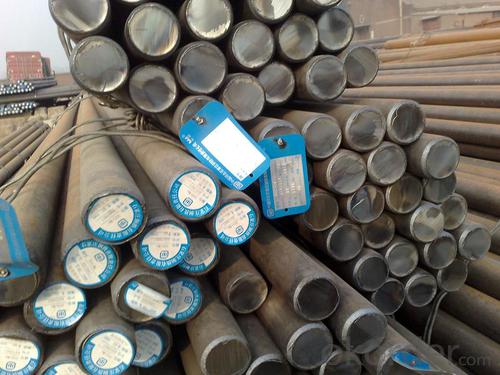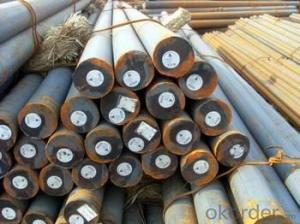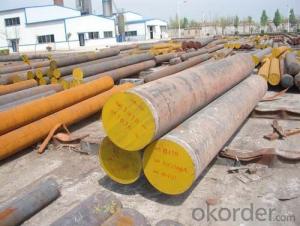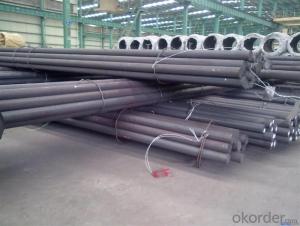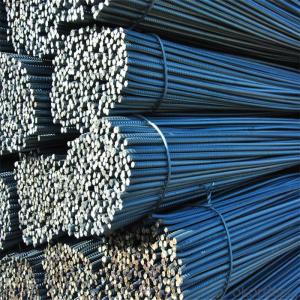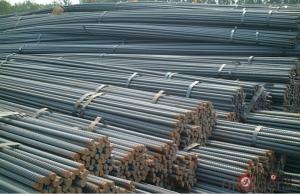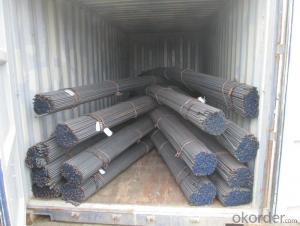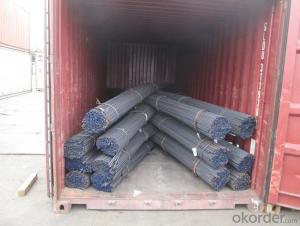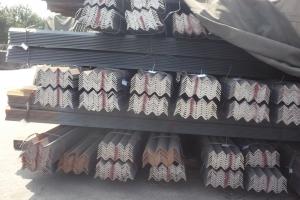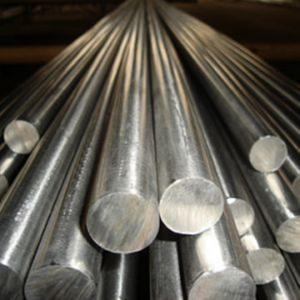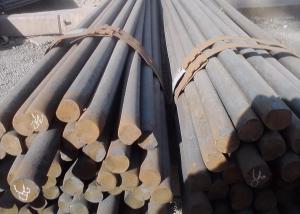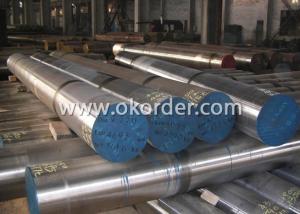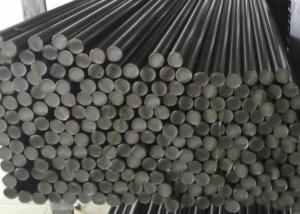Q235 Steel Round Bar From CNBM 16mm-300mm
- Loading Port:
- China main port
- Payment Terms:
- TT OR LC
- Min Order Qty:
- 25 m.t.
- Supply Capability:
- 50000 m.t./month
OKorder Service Pledge
OKorder Financial Service
You Might Also Like
Specification
Q235 Steel Round Bar From CNBM 16mm-300mm
Product Description:
1. Sizes: Diameter: 6mm-150mm; Length: 6m, 9m, 12m
2. Grade: Q195, Q235
3. Invoicing on theoretical weight or actual weight as customer’s request
4. Shape: Round bar, solid bar of steel with circular section
5. Technique: Hot rolled
6. Details of specification
Diameter | Mass | Diameter | Mass | Diameter | Mass |
(mm) | (kg/m) | (mm) | (kg/m) | (mm) | (kg/m) |
6 | 0.22 | 22 | 2.98 | 53 | 17.30 |
7 | 0.30 | 24 | 3.55 | 56 | 19.30 |
8 | 0.40 | 25 | 3.85 | 60 | 22.20 |
9 | 0.50 | 26 | 4.17 | 63 | 24.50 |
10 | 0.62 | 28 | 4.83 | 65 | 26.00 |
11 | 0.75 | 30 | 5.55 | 70 | 30.20 |
12 | 0.89 | 32 | 6.31 | 75 | 34.70 |
13 | 1.04 | 34 | 7.13 | 80 | 39.50 |
14 | 1.21 | 36 | 7.99 | 85 | 44.50 |
15 | 1.39 | 38 | 8.90 | 90 | 49.90 |
16 | 1.58 | 40 | 9.86 | 95 | 55.60 |
17 | 1.78 | 42 | 10.90 | 100 | 61.70 |
18 | 2.00 | 45 | 12.50 | 120 | 88.85 |
19 | 2.23 | 48 | 14.20 | 140 | 120.93 |
20 | 2.47 | 50 | 15.40 | 150 | 138.82 |
Usage and Applications of Steel Round Rod Bar
1. Steel round bar is used in a large number of architectural and engineering structures. Or it can be used in construction of plants for the production of steel house frames, high-voltage transmission towers, bridges, vehicles, boilers, containers, ships, etc.
2. And we can use this kind of product on the performance of the mechanical parts if the demand is not very high.
3. Some especial material steel round bar can be used for main shaft of steamer, hummer shank, with big section and supper force.
Pruduct show:
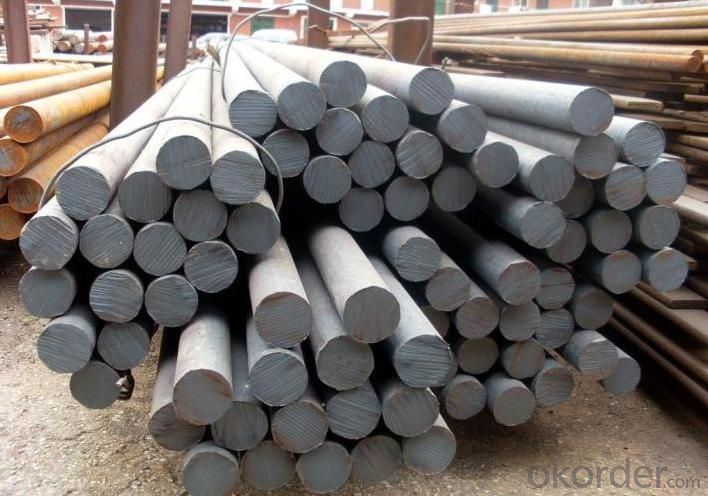
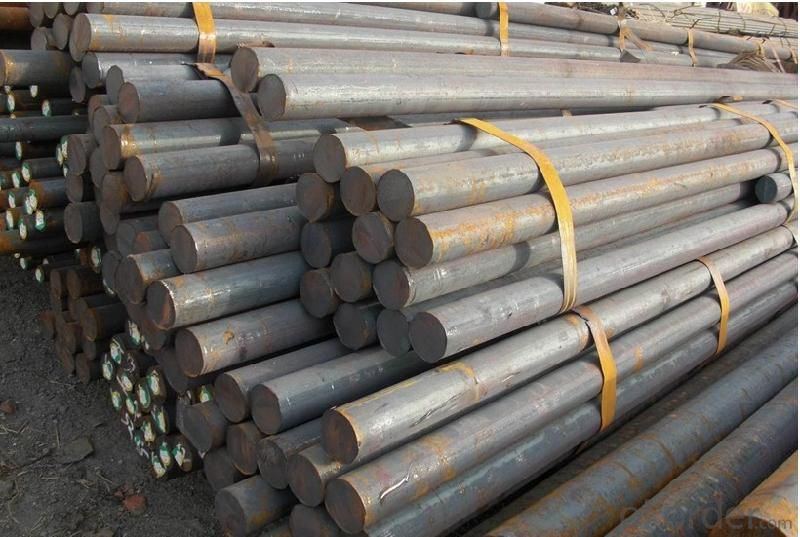

- Q: What are the common quality control measures for special steel?
- Special steel undergoes various quality control measures to ensure its compliance with desired properties and specifications. These measures are as follows: 1. To ensure the required chemical compositions, chemical composition analysis techniques, such as spectrometry, are employed. 2. Mechanical testing, including tensile testing, hardness testing, impact testing, and fatigue testing, is conducted to verify the steel's mechanical properties, such as strength, hardness, toughness, and ductility. 3. Non-destructive testing methods, like ultrasonic testing, magnetic particle testing, and dye penetrant testing, are utilized to detect any internal or surface defects in the steel, ensuring its integrity and reliability. 4. Precise dimensional inspection is carried out to measure critical dimensions, such as length, width, thickness, and diameter, in accordance with customer requirements or industry standards. 5. Surface quality inspection ensures that the steel meets the required surface quality standards by examining it for defects such as cracks, pits, scratches, or unevenness. 6. The effectiveness of the heat treatment process, which includes annealing, quenching, or tempering, is verified through hardness testing or microstructure analysis. 7. Comprehensive documentation and traceability records are maintained to ensure quality consistency and provide a reference for future use or troubleshooting. These records include details of the production process, chemical composition, mechanical properties, and any inspections or tests performed. By implementing these quality control measures, manufacturers can guarantee that special steel meets the required specifications, offering customers high-quality and dependable products for their specific applications.
- Q: Can special steel be used for making food processing equipment?
- Yes, special steel can be used for making food processing equipment. Special steels such as stainless steel are commonly used in the food industry due to their corrosion resistance, hygienic properties, and ability to withstand high temperatures. These steels are suitable for equipment like mixers, tanks, conveyors, and cutting tools, ensuring safety and maintaining high standards of cleanliness in food processing facilities.
- Q: What are the main applications of special steel in the telecommunications sector?
- Special steel is commonly used in the telecommunications sector for various applications. One of the main uses of special steel in this industry is for the manufacturing of transmission towers and antenna structures. These steel structures provide the necessary support and stability for telecommunication equipment, ensuring reliable signal transmission. Additionally, special steel is also utilized in the production of cables and wires, which are crucial for transmitting data and electricity in telecommunication networks. The high strength and durability of special steel make it ideal for withstanding the harsh outdoor conditions that telecommunication infrastructure often faces.
- Q: What are the main advantages of using special steel in the defense industry?
- The main advantages of using special steel in the defense industry are its exceptional strength, durability, and resistance to corrosion. Special steel is able to withstand extreme conditions and high impact forces, making it ideal for producing armor, weapons, and military vehicles. Additionally, its resistance to corrosion ensures that the equipment remains functional even in harsh environments, increasing its longevity and reliability.
- Q: What are the different forging techniques for special steel?
- For special steel, different forging techniques can be utilized depending on the desired properties and characteristics of the final product. Some commonly employed techniques are as follows: 1. Open-die forging, also known as smith forging or hand forging, involves shaping the steel between two flat dies or anvils. The metal is heated and hammered repeatedly until it achieves the desired shape. This technique is suitable for larger and more intricate components like shafts, cylinders, or discs. 2. Closed-die forging, also called impression-die forging, entails shaping the steel within a set of dies that contain the desired shape. The metal is placed between the dies and compressed under high pressure. Closed-die forging is often used for smaller, more intricate components, providing greater control over the final shape and dimensions. 3. Roll forging involves passing the steel between two or more rotating rolls to shape it. The rolls exert pressure on the metal, causing it to deform and acquire the desired shape. This technique is commonly used for producing long, cylindrical components such as axles, bars, or rings. 4. Upset forging involves deforming the steel by reducing its length and increasing its cross-sectional area. The metal is placed between two dies and axially compressed, resulting in bulging and the desired shape. Upset forging is commonly utilized for producing short, thick components like bolts, screws, or nuts. 5. Press forging, similar to closed-die forging, employs a hydraulic or mechanical press to shape the steel. The metal is placed between two dies and compressed under high pressure, allowing controlled deformation. Press forging enables precise control over the shaping process and is often employed for producing high-quality and complex components. Each of these forging techniques possesses its own advantages and limitations, and the choice of technique relies on factors such as size, complexity, and desired properties of the final product. By selecting the appropriate forging technique, manufacturers can ensure that special steel components meet the required specifications and performance standards.
- Q: How does special steel contribute to the fatigue resistance of products?
- The exceptional fatigue resistance of products is attributed to the unique properties and manufacturing processes of special steel. Firstly, special steel is engineered and designed to possess enhanced strength and durability, resulting in high resistance against fatigue. This is achieved by incorporating alloying elements such as chromium, nickel, molybdenum, and vanadium, which enhance the material's ability to withstand cyclic loading and stress. Furthermore, rigorous heat treatment processes, including quenching and tempering, are employed to further improve the fatigue resistance of special steel. These processes refine the microstructure of the material, leading to a more uniform and fine-grained product. Consequently, the steel's ability to resist crack initiation and propagation, which are critical factors in fatigue failure, is significantly enhanced. Moreover, specialized surface treatments like shot peening or nitriding are often applied to special steel. These treatments introduce compressive residual stresses on the material's surface, acting as a barrier against crack formation and growth. This significantly boosts the fatigue resistance of the product. Additionally, special steel can be manufactured with specific grain orientations using directional solidification techniques. This allows for the alignment of grains along the primary loading direction, reducing the likelihood of crack initiation at grain boundaries and further improving the material's fatigue performance. In conclusion, the exceptional fatigue resistance of special steel is a result of its unique properties and manufacturing processes. The combination of enhanced strength, refined microstructure, specialized surface treatments, and tailored grain orientations make special steel the preferred choice in industries where fatigue failure is a concern. This ensures prolonged lifespan and reliability of products.
- Q: How does the heat treatment process affect the properties of special steel?
- The properties of special steel are greatly affected by the heat treatment process. This process involves controlled heating and cooling of the steel to modify its microstructure and, as a result, its mechanical properties. To begin, heat treatment can increase the hardness of special steel. By heating the steel to a specific temperature and then rapidly cooling it through quenching, the steel undergoes a phase transformation that boosts its hardness. This is especially advantageous for applications that demand high strength and resistance to wear, such as cutting tools or bearings. Furthermore, heat treatment can enhance the toughness of special steel. By tempering the quenched steel at a lower temperature, the brittleness caused by rapid cooling can be minimized, leading to improved toughness and ability to withstand impacts. This is crucial in applications where the steel must endure sudden shocks or impacts, like in automotive or aerospace components. Moreover, heat treatment can also improve the overall strength of special steel. Through a combination of heating, cooling, and tempering processes, the steel's grain structure can be refined, resulting in increased strength and resistance to deformation. This is particularly critical for structural applications where the steel must withstand heavy loads or extreme conditions. Additionally, the heat treatment process can influence the corrosion resistance of special steel. By subjecting the steel to specific heat treatment cycles, the formation of certain phases or chemical compounds can be encouraged, leading to enhanced resistance against corrosion or oxidation. This is essential for applications exposed to harsh environments or corrosive substances, such as in marine or chemical industries. In conclusion, the heat treatment process is essential in modifying the properties of special steel. By carefully controlling the heating, cooling, and tempering cycles, the hardness, toughness, strength, and corrosion resistance of the steel can be significantly improved. This allows for the production of special steel with customized properties to meet the specific requirements of various industrial applications.
- Q: How does special steel perform in chemical processing applications?
- Due to its outstanding performance and unique properties, special steel finds wide application in chemical processing. Its high resistance to corrosion is a key advantage in this field. Specifically designed to withstand harsh chemical environments, special steel ensures reliability and durability. Compared to other materials, special steel provides superior protection against corrosion in chemical processing applications where corrosive substances are present. It exhibits exceptional resistance to acids, alkalis, and various chemical compounds, guaranteeing the integrity and longevity of equipment and components. In addition, special steel offers excellent mechanical properties, including high strength and toughness, which are essential in chemical processing. It can endure high temperatures, pressure, and mechanical stresses commonly encountered in these environments. Its robustness and ability to maintain structural integrity under extreme conditions make it the preferred choice for critical components such as reactors, vessels, and piping systems. Special steel also contributes to the overall efficiency and safety of chemical processing operations. Its resistance to scaling and fouling reduces the risk of contamination and blockages, minimizing downtime for cleaning and maintenance. As a result, productivity and cost-effectiveness are improved. Furthermore, special steel is frequently chosen for its hygienic properties, making it suitable for use in the food and pharmaceutical industries. It is easy to clean and sanitize, ensuring the highest levels of product purity and compliance with industry regulations. In conclusion, special steel excels in chemical processing applications. Its corrosion resistance, mechanical strength, thermal stability, and hygienic properties make it an ideal choice for equipment and components, enhancing the reliability, efficiency, and safety of chemical processing operations.
- Q: What are the different applications of stainless special steel?
- Stainless special steel, which is also known as stainless steel, is a highly versatile material that is used in various industries because of its unique properties. Some examples of the different ways in which stainless special steel is utilized include: 1. Construction: Stainless steel is widely employed in the construction industry due to its exceptional durability and resistance to corrosion. It is used in structural components, bridges, building facades, and roofing materials. 2. Automotive industry: The automotive sector extensively utilizes stainless steel because of its strength, ability to withstand high temperatures, and durability. It can be found in exhaust systems, mufflers, catalytic converters, fuel tanks, and various other components. 3. Medical equipment: Stainless steel is the preferred material in the medical field because of its high resistance to corrosion and biocompatibility. It is used in the production of surgical instruments, implants, orthopedic devices, and medical equipment. 4. Food processing industry: Stainless steel is widely employed in the food industry because of its hygienic properties. It is used in the manufacturing of food processing equipment, storage tanks, food preparation surfaces, and utensils. 5. Aerospace industry: Stainless steel is utilized in the aerospace industry for its strength, ability to withstand high temperatures, and resistance to corrosion. It is used in the production of aircraft parts, engine components, and structural elements. 6. Chemical industry: Stainless steel is highly resistant to corrosion from various chemicals, making it suitable for applications in the chemical industry. It is used in the manufacturing of tanks, pipes, valves, and other equipment that come into contact with corrosive substances. 7. Energy sector: Stainless steel is used in the energy industry for various purposes. It is employed in the construction of power plants, oil and gas refineries, pipelines, and renewable energy systems such as wind turbines and solar panels. 8. Marine industry: Stainless steel is extensively used in marine environments because of its excellent resistance to corrosion. It is used in the production of boat fittings, propellers, underwater structures, and offshore platforms. 9. Household appliances: Stainless steel is commonly used in household appliances because of its attractive appearance, durability, and resistance to stains and scratches. It can be found in kitchen appliances such as refrigerators, ovens, dishwashers, and washing machines. 10. Art and design: Stainless steel is increasingly being employed in art installations, sculptures, and architectural designs because of its aesthetic appeal, versatility, and ability to withstand outdoor conditions. In conclusion, stainless special steel is utilized in a wide range of industries due to its durability, resistance to corrosion, strength, ability to withstand high temperatures, and aesthetic appeal. It plays a crucial role in construction, automotive, medical, food processing, aerospace, chemical, energy, marine, household appliances, and artistic fields.
- Q: What are the main factors affecting the fracture toughness of special steel?
- The fracture toughness of special steel is influenced by several main factors. 1. Alloy composition: The specific chemical composition of the steel, including the type and amount of alloying elements, greatly affects its fracture toughness. Elements like chromium, nickel, and molybdenum can improve the toughness by promoting the formation of fine-grained microstructures or enhancing the steel's ability to resist crack propagation. 2. Heat treatment: The heat treatment process, including the temperature and duration of heating and cooling, plays a crucial role in determining the fracture toughness. Proper heat treatment can refine the microstructure and eliminate potential defects, enhancing the steel's resistance to fracture. 3. Microstructure: The microstructure of the steel, such as grain size and distribution, phase composition, and presence of inclusions, significantly affects its fracture toughness. Fine-grained structures generally exhibit higher toughness due to improved resistance to crack propagation. 4. Presence of defects: The presence of defects like cracks, voids, or inclusions in the steel can act as stress concentrators, reducing its fracture toughness. These defects can initiate cracks and propagate them more easily, leading to lower toughness. 5. Temperature: Fracture toughness is temperature-dependent, and the behavior of special steel can vary significantly at different temperatures. Some steels exhibit improved toughness at low temperatures due to the transformation of the microstructure, while others may experience reduced toughness at elevated temperatures due to the softening of the material. 6. Loading conditions: The fracture toughness of special steel can also be influenced by the loading conditions, such as the rate of loading or the presence of dynamic loading. Higher loading rates or dynamic loading can result in reduced toughness as the steel may not have sufficient time to deform and absorb energy before fracture. 7. Mechanical properties: The mechanical properties of the steel, such as strength, hardness, and ductility, can affect its fracture toughness. Higher strength and hardness can sometimes lead to lower toughness, as the material becomes more brittle. However, a balance between strength and toughness can be achieved by carefully selecting the alloy composition and heat treatment parameters. Overall, the fracture toughness of special steel is a complex interplay of various factors, including alloy composition, heat treatment, microstructure, defects, temperature, loading conditions, and mechanical properties. Optimizing these factors can help enhance the fracture toughness of special steel for specific applications.
Send your message to us
Q235 Steel Round Bar From CNBM 16mm-300mm
- Loading Port:
- China main port
- Payment Terms:
- TT OR LC
- Min Order Qty:
- 25 m.t.
- Supply Capability:
- 50000 m.t./month
OKorder Service Pledge
OKorder Financial Service
Similar products
Hot products
Hot Searches
Related keywords



